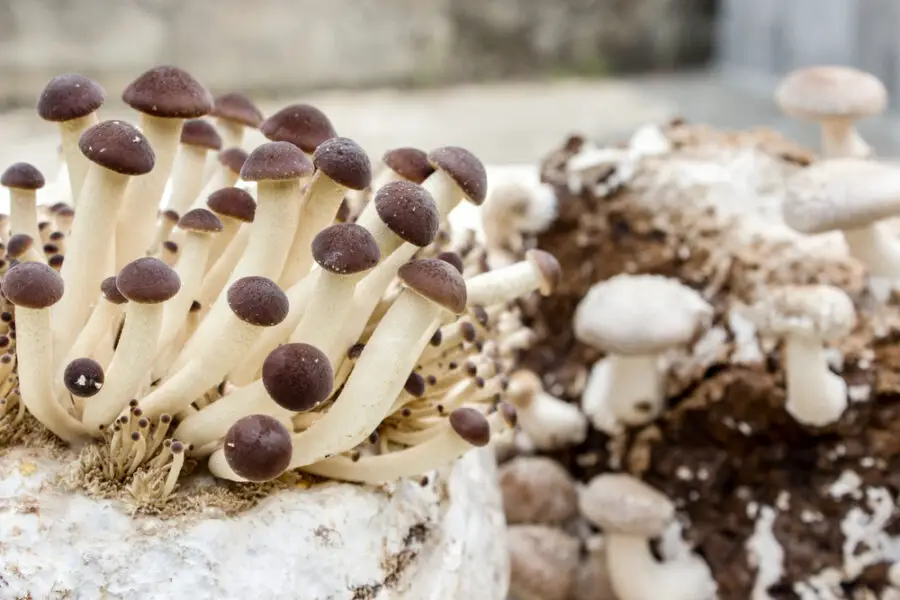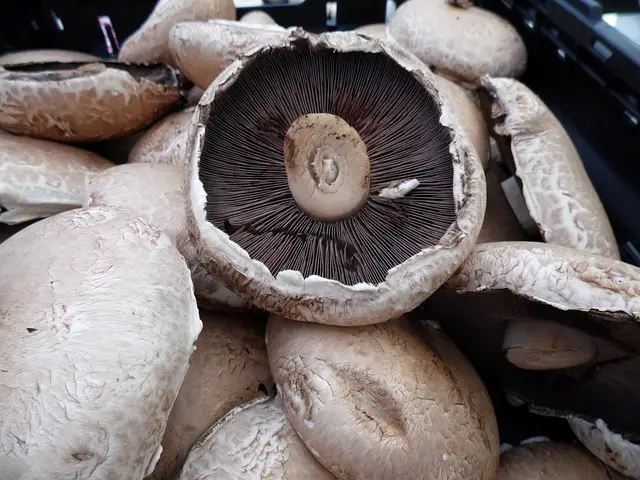Choosing the best substrate for your edible mushroom can make or break your success. Learn the types of substrates, how to make bulk substrates, and the best substrate recipes for oyster, button, shiitake, portobello, and more.
Note: If you click some of the links or pictures in this article we may earn a small commission at no additional cost to you.
The Best Mushroom Substrates
Mushrooms consume carbon-based dead plant matter. Different mushrooms have different favorites. Oyster mushrooms can pretty much grow on anything.
Straw
Straw is a great substrate for finishing oyster mushroom spawn. Before use, it will need to be pasteurized. You can do this easily at home by simply adding straw to a five-gallon bucket, adding boiling water, and maintaining the temperature at 170 Degrees F for one hour.
Keep the heat in by adding blankets on top and checking the temperature regularly. Add more boiling water if needed.
Straw is a cheap, easy to find, and easy to pasteurize substrate.

Coco Coir
Coco coir is another cheap, easy-to-pasteurize substrate. You can also use it to finish oyster mushrooms. Pasteurize it using the methods given above.
To find coco coir you can either buy it online in bulk or get it from local hydroponic or grow stores. It’s frequently used as a soilless growing media in hydroponics and aquaponics.

Logs
Logs can be used to finish shiitake mushrooms or oyster mushrooms. In both cases, you’ll purchase or DIY plug spawn, drill holes into the wood, hammer in the plug spawn, and seal with wax. See full instructions in the How are Mushrooms Grown article.
Logs do not require much watering or maintenance. They should be stored in a shaded location with plenty of ventilation.
What logs do require is patience. It can take 12 to 18 months for plug spawn to grow throughout the logs before they are ready to fruit. In the instructions above steps are given on cold shocking your logs to induce mushroom fruiting.
That can work but you still have to wait 12 to 18 months for mushroom mycelia to grow to the ends of the logs before forcing them to fruit.
Sawdust and Woodchips
Use sawdust or woodchips to grow shiitake or oyster mushrooms. A bag of pasteurized sawdust can be used to grow and finish both mushrooms indoors.
Woodchips can also be used outdoors to grow wine cap mushrooms and other semi-wild mushrooms. Outdoor growing requires identification skills. You must be sure the mushrooms that sprout are edible. Your outdoor woodchips can become contaminated with poisonous mushrooms.
Still, it’s a ton of fun to grow edible semi-wild mushrooms outside, even if you never eat them!

Used Coffee Grounds
Oyster mushrooms do well on used coffee grounds. Plus if you use them fresh after making coffee the grounds come pasteurized. Complete instructions on using coffee grounds to grow oyster mushrooms from stems can be found in our growing guide.
Manure and Compost
Manure and compost mixes are ideal for button, portobello, and crimini mushrooms. You can either purchase manure and compost then pasteurize it, purchase it pasteurized, or make your own at home. Again full instructions on doing this at home can be found in our article about growing mushrooms.
How To Pasteurize & Prepare Bulk Substrate
Bulk substrate for home-growing edible mushrooms is easy. For more detailed information see the step-by-step instructions on how mushrooms are grown.
- Oyster Substrate – Pasteurize straw in 5-gallon buckets using boiling water. Coffee grounds should be pasteurized by first making coffee! Then let the grounds cool and use it to grow oyster mushroom stems into mycelia. Coffee grounds shouldn’t be used as a bulk substrate. It’s hard to prevent infection with coffee grounds as by the time you’ve built up a good amount of grounds they will likely be infected and will need another pasteurization.
- Shiitake Substrate – Obtain hardwood logs that are 3-4 inches in diameter and 3-4 feet long. Logs should be fresh cut from green wood and do not need pasteurization. You can also grow shiitake on wood chips or sawdust. Both will need pasteurization. Use the 5-gallon bucket with boiling water and blankets method as described in the growing guide.
- Button/Portobello Substrate – Button mushrooms do well in a 50/50 mixture of compost and manure. Buy pasteurized versions of both then mix them. Done. You can also make your own compost but you’ll still need to purchase manure unless you have farm animals. Either way, DIY compost, and manure both still need pasteurization. If you make compost using high heat methods (e.g. large piles that generate lots of heat) then it will be pasteurized and ready to use. The easiest way to do high heat compost is to build a compost bin out of wooden pallets so it’s 4 feet x 4 feet x 4 feet minimum. Then fill it with the proper nitrogen/carbon mix of green materials and brown materials (1:2 ratio of greens to browns). Get a compost thermometer and ensure it gets to at least 120 degrees F for a few days. Then you’ve got pasteurized compost (at least in the center of the pile and on top).
Best Substrate Recipe For Growing Oyster Mushrooms
The best recipe for oyster mushrooms is used coffee grounds for stage 1 then pasteurized straw for stage 2.
- Start with oyster mushrooms stems from the store
- Grow those on used coffee grounds that were freshly cooked and are warm but not hot to the touch
- Finish in pasteurized straw
Best Substrate For Growing Button Mushrooms
- 50% Pasteurized Compost
- 50% Pasteurized Manure
- Soil to cover the substrate about an inch deep to inspire mushroom fruiting
Best Substrate For Growing Portobello Mushrooms
Use the same recipe as for growing button mushrooms (50% pasteurized compost with 50% pasteurized manure with one inch of pasteurized soil on top).
Best Substrate For Growing Shiitake Mushrooms
Shiitakes grow best on logs, wood chips, or sawdust. Logs should be cut green then inoculated before getting infected. Wood chips and sawdust should be pasteurized by adding boiling water and maintaining a temperature of 170 degrees F for at least 1 hour.
Best Substrate For Growing King Oyster Mushrooms
King oyster mushrooms can grow in the same substrate as oyster mushrooms. Start them in coffee grounds then finish in pasteurized straw. Coffee grounds will be pasteurized by brewing the coffee than using the grounds just after they are warm to the touch but not hot. Straw can be pasteurized by soaking in boiling water in a 5-gallon bucket for at least an hour. Keep the water above 170 Degrees F by adding boiling water. Check the temperature every 15 minutes and let sit for 1-2 hours.
Mushroom Substrate Chart
| Substrate | Oyster | Button | Portobello or Crimini | Shiitake | King Oyster |
| Straw | X | X | X | X | |
| Coco Coir | X | X | |||
| Logs | X | X | X | ||
| Sawdust or Woodchips | X | X | X | ||
| Used Coffee Grounds | X | X | |||
| Manure | X | X | X | ||
| Compost | X | X | X |
What Is Mushroom Substrate?
A mushroom substrate is a medium used to grow mushrooms. Typical commercial cultivation happens in three steps:
- Grow mycelium from spores or stems of old mushrooms
- Continue growing mycelium into spawn. Spawn is just larger chunks of mycelium and medium that can be spread into larger batches.
- Grow spawn in large media batches till mushrooms fruit
When growing mushrooms at home you usually skip the spore step and even the spawning step. You can buy mushroom kits that start at step 3 so all you do is water and then wait for fruit.
You can grow oysters from stems of old mushrooms by starting them on used coffee grounds then adding that to pasteurized straw.
You can also buy spawn kits and start at step 2, moving the spawn to a homemade mushroom substrate ideal for the mushroom you’re growing.
You can start most homegrown edible mushrooms from spores of your old mushrooms but this step is difficult, requires special care to prevent infecting your mushrooms, and needs special equipment.
How Long Does Mushroom Substrate Last?
Mushroom substrate should be used once then added to the compost pile. If you have chickens or pigs you can offer the substrate to them to let them pick out/eat the mushroom mycelia.
In general, there are two ways to grow mushrooms – by reproducing from the mycelia or mushroom stems and by growing from fresh spores.
Both work so in theory you could keep growing more mushrooms by adding old mushroom substrate to fresh substrate. The old mycelia will grow into the new substrate and eventually form new mushrooms.
There are 2 dangers with this method.
- Your old substrate is probably contaminated with other mushrooms just waiting to grow and take over. You should never eat contaminated mushrooms as the other mushroom could be poisonous.
- Eventually, the old mycelia get old. You’ll want to refresh its vitality by growing from spores. This requires super clean methods
In either case above you still need a new substrate eventually.
What Do You Do With Spent Mushroom Substrate?
Feed spent mushroom substrate to your chickens, pigs, or your compost pile. All will enjoy it though the chickens and pigs will make a mess. Your compost pile will in turn make new compost (if you add additional greens and browns) that you can use to make more button mushrooms.
Consider spent mushroom compost that is filled with white mushroom mycelia (roots) as a green and mix it with 2 parts browns (e.g. dry leaves) to make new compost.



